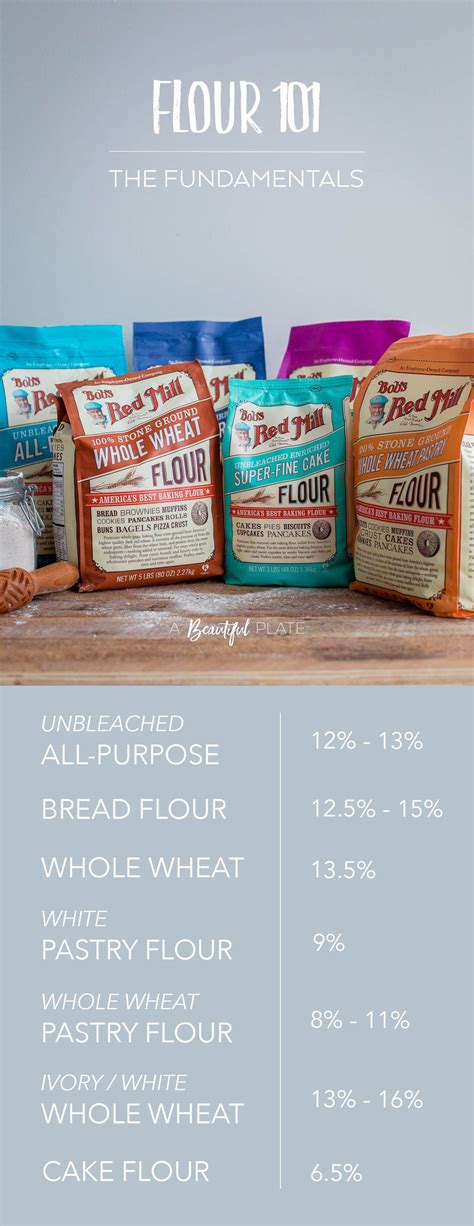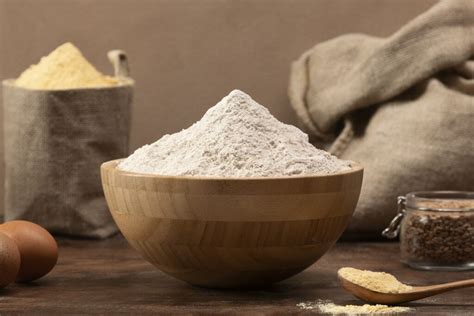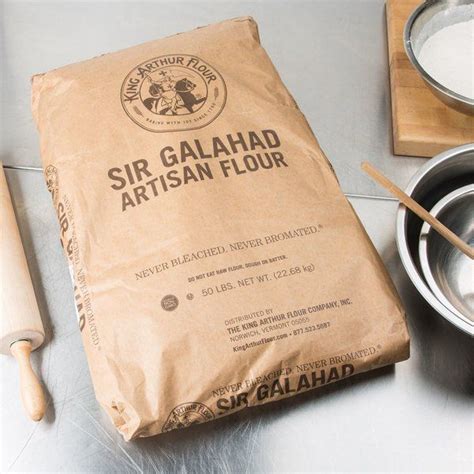Embark on a journey through the realm of gastronomy, where culinary magic is conjured through the transformation of a humble ingredient known as flour. Within this enigmatic world lies an artistry that transcends the boundaries of taste, texture, and aroma. Fascinating combinations, delicate techniques, and innovative approaches await, promising to elevate your culinary prowess to new heights.
Indulge your senses and stimulate your creativity as you explore the myriad possibilities that flour offers in the realm of cooking. This versatile component, with its abundant variations and rich history, becomes the foundation upon which the most extraordinary dishes are built. From decadent cakes that delight the palate to luscious pastas that hug every strand of sauce, flour weaves its enchantment, transforming raw ingredients into edible masterpieces.
Through the alchemy of culinary experimentation, you can unearth the countless secrets that lie hidden within the seemingly simple nature of flour. Unleash the power of gluten and witness how it gives rise to fluffy breads and crispy crusts. Immerse yourself in the world of batters and dough, understanding the delicate dance between liquid and solid that results in delicate pastries and savory treats. Embrace the therapeutic joy of kneading dough and feel the connection to countless generations that have come before you, united by the universal language of food.
Understanding the Basics: Exploring Different Types of Flour

Unraveling the fundamentals behind the intricate world of flour is essential for any aspiring chef. This section aims to delve into the various types of flour, providing a comprehensive understanding of their unique characteristics and culinary applications.
- All-Purpose Flour: This versatile flour, widely used in baking and cooking, serves as the perfect foundation for a multitude of recipes. With its balanced blend of protein and gluten, all-purpose flour can be used to create a wide range of both savory and sweet dishes.
- Whole Wheat Flour: A healthier alternative to refined flour, whole wheat flour retains the wheat germ and bran, resulting in a higher nutritional value. Its slightly nutty flavor and denser texture make it an excellent choice for whole grain breads, muffins, and pancakes.
- Bread Flour: With a higher protein content, bread flour possesses exceptional gluten-forming properties, making it the go-to choice for making yeasted breads and rolls. It ensures a strong structure and chewy texture, ideal for capturing those delicious air pockets.
- Cake Flour: This finely milled flour is specifically designed to produce tender and delicate cakes. Its low protein content ensures a lighter texture and a velvety crumb, perfect for achieving those picture-perfect layers.
- Pastry Flour: The ideal flour for creating flaky and tender pastries, pastry flour strikes the right balance between protein and starch content. Its fine texture and softness help achieve delectable pie crusts, biscuits, and tarts.
By familiarizing yourself with the unique properties of each type of flour, you can unlock endless possibilities in the kitchen. Experimentation with different flours will allow you to elevate your culinary creations and embark on a flavorful journey that transcends mere sustenance.
From Ancient Grains to Gluten-Free Alternatives: The Evolution of Flour in Culinary Delights
In this section, we will explore the fascinating journey of flour in the realm of cooking. From ancient times to the modern culinary landscape, the use of different types of flour has evolved over the years, presenting diverse options and opportunities for chefs and home cooks alike. Captivating tales of age-old grains and innovative gluten-free alternatives will take us on a flavorful adventure through time.
Throughout history, civilizations around the world have relied on various grains to create their staple food. These ancient grains were not only nourishing but also held cultural and historical significance. Today, their legacy lives on as they continue to inspire culinary creations, infusing them with a touch of tradition and heritage.
| Ancient Grains | Gluten-Free Alternatives |
|---|---|
| Emmer | Rice Flour |
| Einkorn | Almond Flour |
| Kamut | Coconut Flour |
| Amaranth | Buckwheat Flour |
With the rise of gluten intolerances and dietary preferences, the culinary world has also witnessed the emergence of gluten-free alternatives to traditional flour. These alternatives provide a solution for individuals who need or choose to avoid gluten, opening up a whole new realm of culinary possibilities.
Each type of flour has its unique characteristics, influencing the taste, texture, and overall outcome of dishes. It is through experimenting with these diverse flour options that culinary enthusiasts can unlock their creativity and discover exciting new flavors and textures in their cooking.
Whether you embark on a journey back in time with ancient grains or embrace the modern world of gluten-free alternatives, the evolution of flour in cooking ensures that there is something for every aspiring chef or passionate home cook. So, prepare to embark on a culinary adventure and let the versatility of flour expand your culinary horizons!
Flour Power: Unleashing the Versatility of Flour in Your Recipes

Experience the incredible potential of flour as you dive into the culinary world. By harnessing the exceptional versatility and transformative properties of this humble ingredient, you can elevate your cooking to new heights and create dishes that are both sensational and satisfying.
Flour, a fundamental component in cooking, plays a key role in binding ingredients, adding structure, and creating impressive textures. Its ability to absorb liquids, form doughs, and create batters opens up a world of possibilities in the kitchen.
From the delicate finesse of a flaky pastry to the hearty goodness of freshly baked bread, flour can take on many forms and flavors. It serves as the foundation for sweet treats like cakes, cookies, and pastries, as well as savory delights such as pasta, dumplings, and sauces.
- Discover how a sprinkle of flour can thicken soups, stews, and sauces, ensuring the perfect consistency every time.
- Explore the art of making your own pasta from scratch, using different types of flour to achieve varying textures and tastes.
- Learn the secrets behind creating light and airy breads by mastering the science of dough fermentation.
- Unleash your creativity by experimenting with gluten-free flours, discovering new possibilities for those with dietary restrictions.
- Unlock the potential of ancient grains and alternative flours to add depth and complexity to your recipes.
Whether you are a seasoned chef or a novice in the kitchen, understanding the versatility of flour and its various forms will elevate your cooking endeavors. Get ready to embark on a delicious journey where the possibilities are endless and the results are truly inspiring!
Mastering the Techniques: Tips and Tricks for Flour-based Culinary Creations
Enhance your cooking skills and unlock the secrets to creating delectable dishes by mastering the art of using flour. In this section, we will delve into various techniques, tips, and tricks that will elevate your culinary creations to new heights.
- The Importance of Measuring: Accurate measuring of flour is crucial for achieving consistent and delicious results. Use a scale for precise measurements or spoon and level your flour for better accuracy.
- The Perfect Texture: Achieving the desired texture in your baked goods involves understanding the different types of flour available. Experiment with all-purpose flour, bread flour, cake flour, and whole wheat flour to find the perfect balance for your recipes.
- Mastering the Dough: Understanding the art of kneading and properly developing gluten is essential for creating light and airy breads and pastries. Learn the techniques for kneading dough by hand or using a stand mixer to achieve the desired texture.
- Leavening Agents: Learn about the various leavening agents such as baking powder, baking soda, and yeast, and how they interact with flour to create lift and rise in your baked goods. Discover the proper ratios and usage for each leavening agent.
- Gluten-Free Alternatives: Explore the world of gluten-free baking by learning about alternative flours such as almond flour, coconut flour, and gluten-free all-purpose flour. Discover the best practices for using these flours and creating delicious gluten-free treats.
- Thickening Sauces and Soups: Flour can also be used as a thickening agent in savory dishes. Learn the techniques for creating a roux or a slurry to add body and richness to your sauces, soups, and stews.
- Substitutions and Adaptations: Sometimes, you may find yourself short on a particular type of flour. Discover the art of substituting different types of flour to achieve similar results. Learn how to adapt recipes based on dietary restrictions or personal preferences.
- Storage and Shelf Life: Proper storage of flour is essential to maintain its freshness and quality. Learn the best practices for storing different types of flour to prolong their shelf life and prevent spoilage.
By mastering these techniques, you will have the knowledge and skills to create culinary masterpieces using flour as your canvas. Experiment, explore, and let your creativity soar as you embark on this delicious journey!
Elevate Your Baking: Creating Delectable and Stunning Pastries with the Magic of Flour

Embark on a culinary journey that will take your baking skills to new heights by exploring the endless possibilities of flour. In this section, we will delve into the art of crafting mouthwatering pastries that not only taste heavenly but also captivate with their exquisite beauty.
When it comes to baking, flour serves as the foundation for creating a myriad of pastry delights. It acts as a canvas where flavors, textures, and aromas blend harmoniously, giving rise to delectable treats that are a feast for the senses. With the right techniques and a dash of creativity, you can transform simple ingredients into works of art that will leave your loved ones in awe.
- 1. Experiment with Different Flour Varieties: Just like an artist explores various mediums, discover the diverse world of flour. From all-purpose flour to cake flour, whole wheat flour to rye flour, each imparts a unique character to your pastries. Dive into the nuances of different varieties and unleash your artistic instincts to create pastries that stand out.
- 2. Master the Art of Dough Making: Whether it's flaky pie crusts, buttery croissants, or tender scones, the key to crafting exquisite pastries lies in mastering the art of dough making. Learn the secrets of achieving the perfect texture, balance, and elasticity in your dough to elevate your baking creations to perfection.
- 3. Embrace Flavor Pairings: Like a painter's color palette, the right combination of flavors can elevate your pastries from delicious to extraordinary. Explore the art of flavor pairing by experimenting with complementary ingredients that bring out the best in each other. From classic combinations like chocolate and hazelnut to unexpected surprises like lavender and lemon, let your taste buds guide you towards harmonious flavors.
- 4. Decorating with Finesse: Just as a painter adds intricate details to their masterpiece, the art of pastry lies in the finesse of decoration. Learn the art of piping, glazing, and garnishing to add the perfect finishing touches to your creations. Let your imagination run wild as you create intricate designs, delicate patterns, and captivating presentations that will leave your guests in awe.
- 5. Inspire Your Taste Buds: To truly elevate your baking, seek inspiration from the world of culinary arts and beyond. Explore different cultures, cuisines, and emerging food trends to infuse your pastries with unique flavors and concepts. Let your passion for baking and your love for exploration come together to create pastries that tell a story and leave a lasting impression.
Elevate your baking skills and transform flour into a tool for crafting not only delicious but also visually stunning pastries. With dedication, practice, and a sprinkle of ingenuity, unlock your potential as a pastry artist and bring your baking dreams to life.
Exploring the Versatility of Flour in Savory Dishes
Unlocking the potential of flour: In the world of cooking, flour is often associated with baking and bread-making. However, its potential goes far beyond these common uses. When it comes to savory dishes, flour can be an indispensable ingredient that adds texture, thickness, and flavor to a wide range of recipes.
Creating delectable sauces: Flour serves as a fundamental element in creating rich and flavorful sauces. By incorporating it into your recipes, you can achieve the desired consistency and enhance the depth of flavors. Whether you're making a velvety gravy, a creamy béchamel sauce, or a luscious roux, flour acts as the secret ingredient that brings it all together.
Adding a crispy touch: Flour can be used to achieve that coveted crispy texture in savory dishes. From coating proteins before frying, such as chicken or tofu, to making savory pancakes or fritters, a touch of flour can elevate your creations to new heights.
Binding ingredients with finesse: When it comes to meatballs, patties, or vegetarian alternatives, maintaining the perfect consistency is crucial. Flour acts as a binder, ensuring that your mixture holds together, resulting in a satisfying and cohesive end product.
Exploring ethnic flavors: Embark on a culinary journey by incorporating flour into traditional ethnic recipes. From Indian pakoras to Italian gnocchi, flour plays a significant role in these dishes, adding authenticity and creating a unique culinary experience.
Experimenting with different types of flour: Expand your horizons by exploring the vast variety of flours available. From all-purpose flour to whole wheat, gluten-free alternatives, or even nut-based flours, each type brings its own distinct texture and flavor profile to savory dishes, allowing for endless possibilities.
Unleashing your creativity: With flour as your culinary ally, the sky's the limit. Don't be afraid to experiment, mix flavors, and create your own signature dishes. Embrace the versatility of flour and let your imagination run wild in the kitchen, turning your savory dreams into reality.
FAQ
What are some popular dishes that can be made using flour?
Flour is a versatile ingredient that can be used to make a variety of dishes such as bread, pasta, pancakes, cakes, and cookies.
Can you provide some tips on how to make the perfect bread using flour?
To make the perfect bread using flour, it is important to use high-quality flour, knead the dough thoroughly, let it rise in a warm place, and bake at the right temperature for the recommended time.
Are there any alternative flours for people with gluten intolerance?
Yes, there are several alternative flours available for people with gluten intolerance, such as almond flour, coconut flour, and rice flour. These flours can be used to make gluten-free versions of various dishes.
How can I incorporate flour into my everyday meals?
Flour can be incorporated into everyday meals in several ways. It can be used as a thickening agent for soups and sauces, as a coating for frying foods, or as a base for homemade pizzas and quiches.
Is it possible to make desserts without using flour?
Yes, it is possible to make desserts without using flour. There are many flourless dessert recipes available that use ingredients such as nuts, fruits, and chocolate to create delicious treats.



